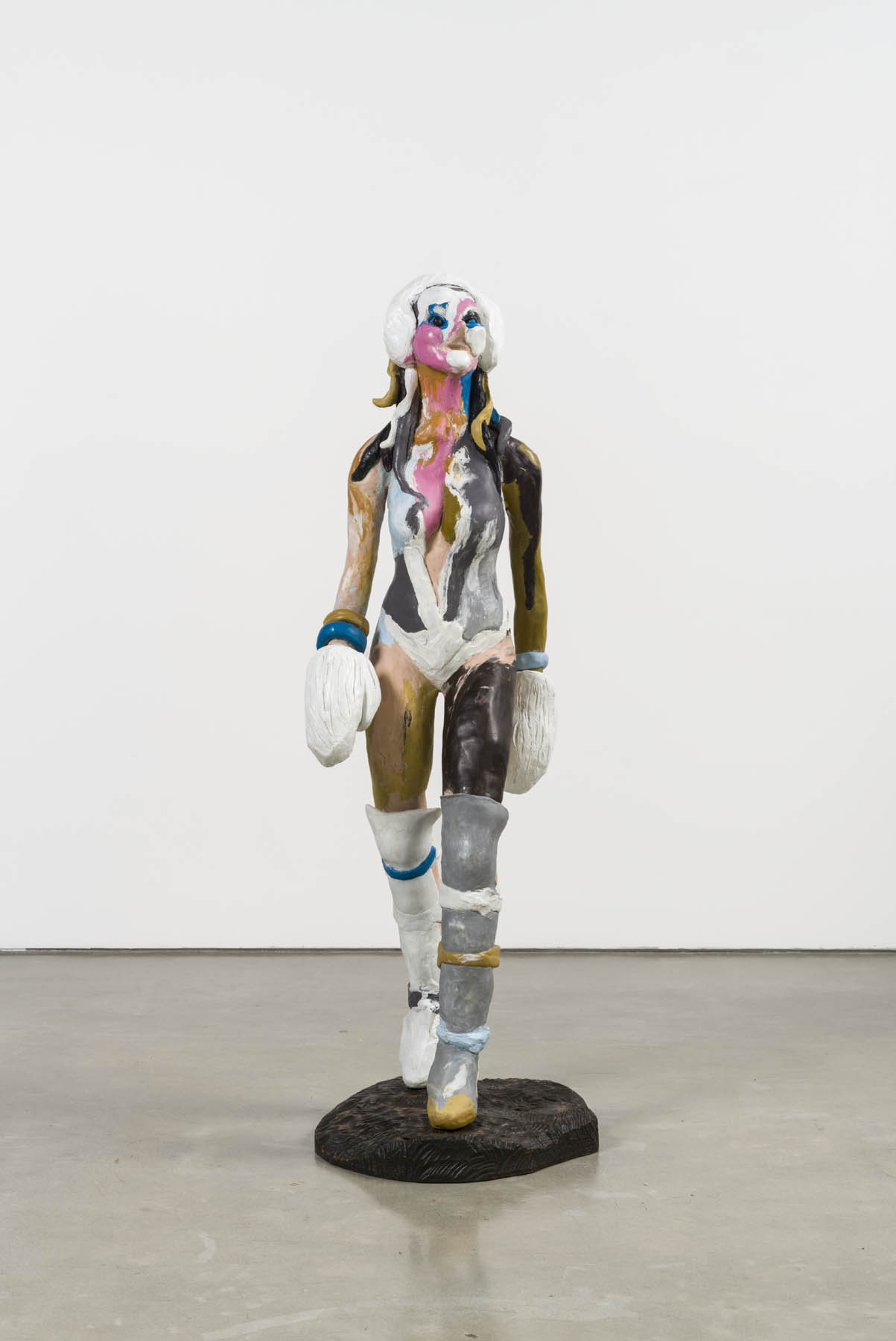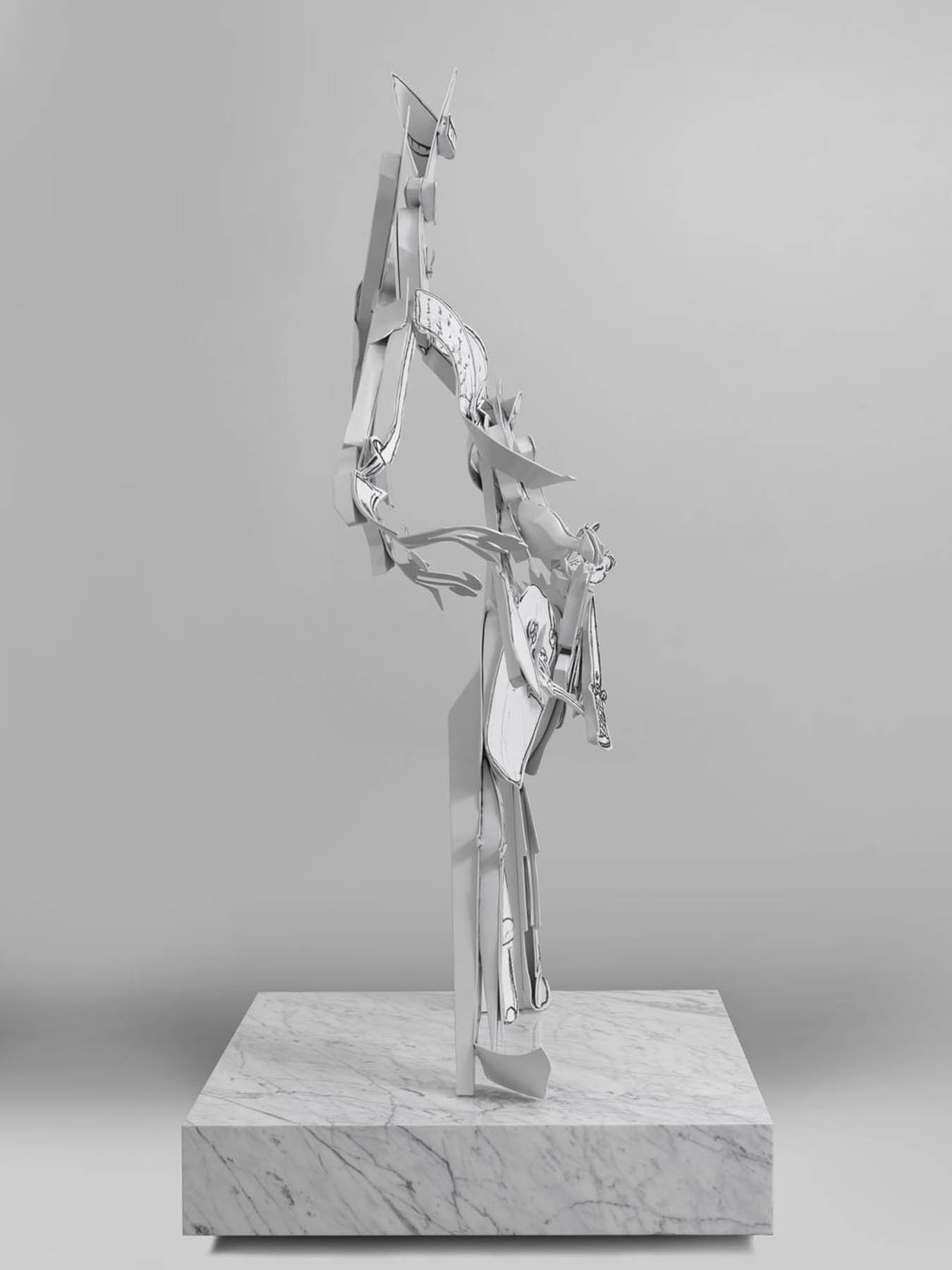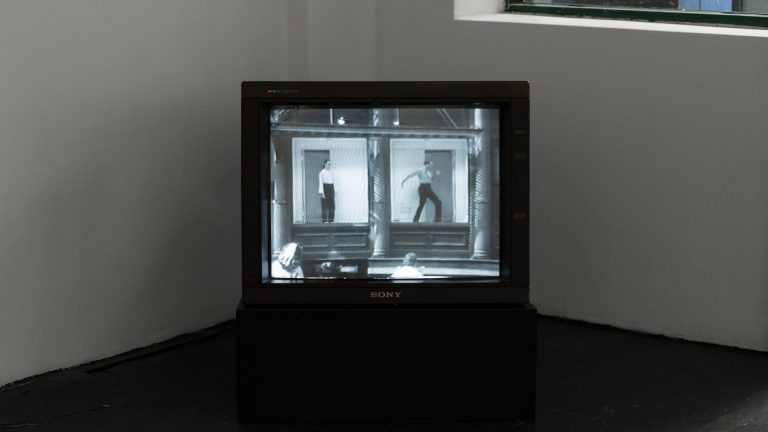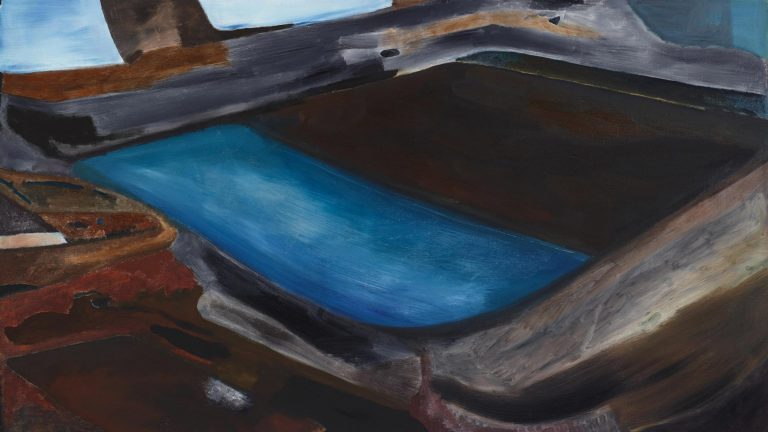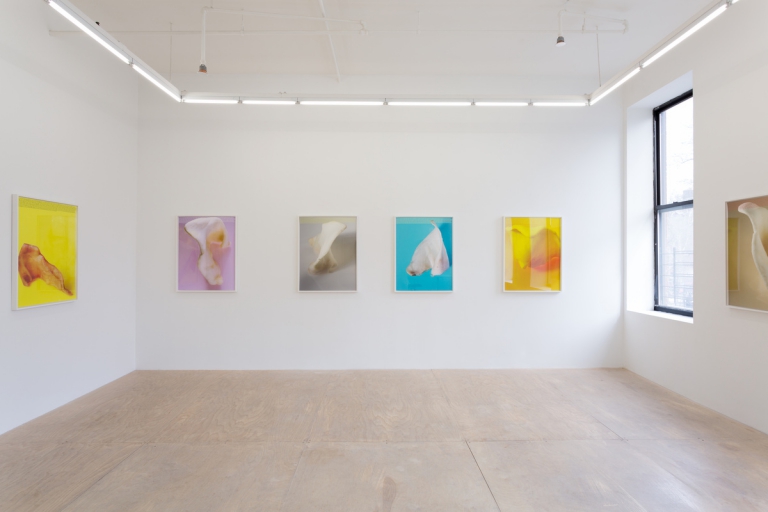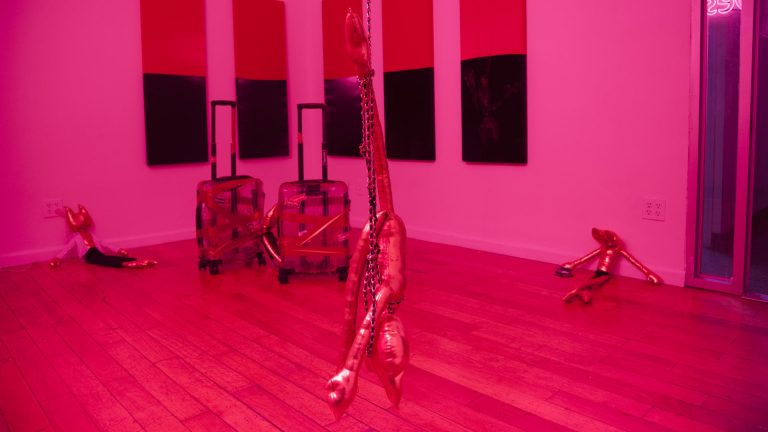Artist: Rachel Feinstein
Exhibition title: Maiden, Mother, Crone
Organized by: Kelly Taxter, Barnett and Annalee Newman
Venue: The Jewish Museum, New York, US
Date: November 1, 2019 – March 22, 2020
Photography: all images copyright and courtesy of the artist and The Jewish Museum, New York
New York, NY, October 24, 2019 — The Jewish Museum will present Rachel Feinstein: Maiden, Mother, Crone, the first survey of the New York-based artist in the United States, from November 1, 2019 through March 22, 2020. The exhibition includes three decades of Feinstein’s work in sculpture, painting, and video, as well as a panoramic wallpaper, a major new commission, and the artist’s maquettes for sculpture. Taken together, the works emphasize the artist’s fascination with dualities: her investigations of masculinity and femininity or good and evil echo her formal explorations of balance and precariousness or positive and negative space. Feinstein’s art follows myriad lines of inquiry, but the idea of the feminine is central. She has made a sustained examination of the many ways this concept is manifested culturally. Female protagonists and figures proliferate in her work and bind it together across diverse media.
The exhibition’s title, Maiden, Mother, Crone, names three consequential stages in a woman’s life, a progression from youth to old age that also signals her accumulation of knowledge and complexity. With the title, Feinstein is thinking of the neopagan deity the Triple Goddess — a simultaneous embodiment of maiden, mother, and crone — in whom past and present, inexperience and wisdom, fragility and power are inextricably entwined.
Feinstein draws upon incongruous sources, time periods, and ideas, and her subjects, too, are drawn from oppositions and tensions: religion and fairy tales, high European craft and low American kitsch, and her needs as an artist and the needs of her family. She explores these conflicts through characters borrowed from biblical and folk sources as well as objects from material culture, deconstructed and reimagined, suggesting that there is no fact without fiction, light without darkness, tranquility without chaos.
Sculpture is Feinstein’s primary medium, but her process embraces divergent methods and materials. Her three-dimensional objects evolve from two-dimensional sketches translated into small handmade maquettes, which are then exploded to larger-than-life-size scale and fabricated in wood, metal, or ceramic. Traces of an object’s hand-drawn origins may survive in a monochromatic palette, compressed depth, or sweeping, organic lines. Her polychrome figures are as painterly as they are sculptural, composed with bright hues and subtle tones built up with layers of pigmented synthetic resin.
Rachel Feinstein: Maiden, Mother, Crone is presented in the Museum’s first floor galleries. The exhibition design, by Annabelle Selldorf of Selldorf Architects, is inspired by Feinstein’s dualistic approach: it juxtaposes hard, geometric shapes against curvilinear edges and enclosures. It also plays upon the latent theatricality of the plain space, where the scaffolded ceiling suggests an empty soundstage. Each of the exhibition’s spaces contains elements reminiscent of stage scenery — a theatrical curtain, video, and panoramic wallpaper. These echo Feinstein’s early experiments with performance, in which she positioned herself as both the subject and object of the viewer’s gaze.
Feinstein studied religion and studio art while an undergraduate at Columbia University. She frequently turns to narrative subjects: figures from the Hebrew and Christian Bibles appear alongside protagonists from Hans Christian Andersen’s fairy tale The Snow Queen or fantastical characters inspired by her personal history and family. The entrance to the exhibition features three sculptures drawn from these sources. All-white, gesturally figurative interpretations of St. Sebastian and St. Michael (both 2012) flank Model (2000), an abstract, voluptuously proportioned tower dotted with circular mirrored discs. Its variously angled, reflective surfaces destabilize, fragment, and unite. Model points to the artist’s own origin story; Feinstein worked as a fashion model throughout her teenage years. From a young age she was both acutely aware of the power of her own image as well as the problematic repercussions of striving for ideals.
On either side of the entrance, two room-encompassing works define the west and east areas of the gallery. Goldstein (2019), a newly commissioned, 40-foot wall relief made of white, enameled wood is to the west. It depicts an outsized mansion swallowed by palm trees and flora; Feinstein reveals what lurks beneath a gilded surface. She grew up in Miami in the 1980s and her work is deeply informed by the foreboding undertones of the city during that era, the encroachment of its lush tropical landscape on crumbling Art Deco architecture, and the insinuation of a thriving drug culture into everyday life.
To the east is Panorama of Rome, a wallpaper designed by Feinstein and based on her 40-foot painting on mirror of the same name. Encircling the space, the wallpaper offers views of the city punctuated by ancient ruins. The gesture of bringing the outside in extends through the room: the pathways created by the sculpture platforms evoke the geometric design of a Baroque Italian garden, dotted with statues and follies. Yet this scene is not entirely picturesque. Feinstein taps into the dark resonances of luxury; for her, the absolutism and exuberant decadence of the aristocracy — as expressed in palaces, furniture, and art — foreshadowed the rise of Fascism, which devastated Europe in the twentieth century. The objects gathered here — including Bleeding Shepherdess (2014) and Icicles (2018 — allow strength and weakness, beauty and decay, chaos and order to coexist.
The video Spring and Winter (1994/96), the earliest piece in the exhibition, is presented in a darkened, centrally located interior space, alongside sexually charged works that meditate on lust, love, and coupling — at once empowered, aggressive, playful, and conflicted. They express a spectrum of desire and draw from myth, popular storytelling, and everyday life. Spring and Winter has an ambiguous tone; it was inspired both by the true story of a romance between Arthur and Nan Kellam and by the violent original version of the fairy tale Sleeping Beauty. The Kellams lived in blissful isolation for 35 years on Placentia Island, off the coast of Maine. After Arthur’s death Nan lived there alone, and her commitment to solitude intrigued Feinstein. To create the video’s set, Feinstein completely transformed her apartment with garbage bags, spray paint, and fabric, temporarily usurping reality with fantasy. Spring and Winter’s sinister elements evolved from a performance she enacted in 1994: for six weeks she slept during the day in a Manhattan gallery, lying beneath an undulating bedspread topped with a grotesque castle. The discomfiting scene was inspired by the source of Sleeping Beauty; Giambattista Basile’s Sun, Moon, and Talia (1634), which centers on a girl raped, not rescued, by a king.
Rachel Feinstein was born in Fort Defiance, Arizona in 1971. She received her BA from Columbia University in 1993, where she studied studio art and religion and worked closely with Kiki Smith and Ursula von Rydingsvard. That same year she attended the Skowhegan School of Painting and Sculpture. Beginning with the group exhibition Let The Artist Live, at New York’s Exit Art in 1994, Feinstein has continued to exhibit her work internationally. Recent solo exhibitions include: Folly, Madison Square Park, New York; The Snow Queen, Lever House, New York; and Tropical Rodeo, Le Consortium, Dijon. She has been included in numerous group exhibitions including at the Minsheng Art Museum, Shanghai; The Arnold and Marie Schwartz Gallery Met, New York; SCAD Museum of Art, Savannah; and the Barbican, London. Feinstein is represented by Gagosian Gallery.
Rachel Feinstein: Maiden, Mother, Crone is organized by Kelly Taxter, Barnett and Annalee Newman Curator of Contemporary Art, The Jewish Museum. Selldorf Architects, New York, contributed the exhibition design with exhibition graphics by Topos Graphics.
A companion monograph, designed by Richard Pandiscio and published by Rizzoli Electa, is available, with a lead essay by Taxter and contributions by Marc Jacobs, Florence Welch, Sofia Coppola, Tamara Jenkins, Ursula von Rydingsvard, Sarah Sze, and Lisa Yuskavage, among others. The hardcover book (248 pages/346 color illustrations) will be available in the Jewish Museum’s Cooper Shop for $75.
Support
Rachel Feinstein: Maiden, Mother, Crone is made possible by the Knapp Family Foundation, The Susan and Leonard Feinstein Foundation, Ann and Mel Schaffer, the Melva Bucksbaum Fund for Contemporary Art, the Peter Jay Sharp Exhibition Fund, and The Barnett and Annalee Newman Foundation. In-kind support is provided by Gagosian Gallery.
About the Jewish Museum
Located on New York City’s famed Museum Mile, the Jewish Museum is a distinctive hub for art and Jewish culture for people of all backgrounds. Founded in 1904, the Museum was the first institution of its kind in the United States and is one of the oldest Jewish museums in the world. Devoted to exploring art and Jewish culture from ancient to contemporary, the Museum offers diverse exhibitions and programs, and maintains a unique collection of nearly 30,000 works of art, ceremonial objects, and media reflecting the global Jewish experience over more than 4,000 years.
Installation view of Rachel Feinstein: Maiden, Mother, Crone, November 1, 2019-March 22, 2020, at the Jewish Museum, NY. Artwork © Rachel Feinstein. Photo: Tom Powel Imaging
Installation view of Rachel Feinstein: Maiden, Mother, Crone, November 1, 2019-March 22, 2020, at the Jewish Museum, NY. Artwork © Rachel Feinstein. Photo: Tom Powel Imaging
Installation view of Rachel Feinstein: Maiden, Mother, Crone, November 1, 2019-March 22, 2020, at the Jewish Museum, NY. Artwork © Rachel Feinstein. Photo: Tom Powel Imaging
Installation view of Rachel Feinstein: Maiden, Mother, Crone, November 1, 2019-March 22, 2020, at the Jewish Museum, NY. Artwork © Rachel Feinstein. Photo: Tom Powel Imaging
Installation view of Rachel Feinstein: Maiden, Mother, Crone, November 1, 2019-March 22, 2020, at the Jewish Museum, NY. Artwork © Rachel Feinstein. Photo: Tom Powel Imaging
Installation view of Rachel Feinstein: Maiden, Mother, Crone, November 1, 2019-March 22, 2020, at the Jewish Museum, NY. Artwork © Rachel Feinstein. Photo: Tom Powel Imaging
Installation view of Rachel Feinstein: Maiden, Mother, Crone, November 1, 2019-March 22, 2020, at the Jewish Museum, NY. Artwork © Rachel Feinstein. Photo: Tom Powel Imaging
Rachel Feinstein, Icicles, 2018, Polyester resin and pigment over foam with wooden base, Los Angeles County Museum of Art, Gift of Allison and Larry Berg, Artwork © Rachel Feinstein; photograph by Jeff McLane
Rachel Feinstein, Adam and Eve, 2007, Stained wood, Collection of Mima and César Reyes, San Juan, Puerto Rico, Artwork © Rachel Feinstein; photograph by Marcus Leith
Rachel Feinstein, Mr. Time, 2015, Powder-coated aluminum, vinyl, and working clock, Courtesy of the artist and Gagosian Gallery, Artwork © Rachel Feinstein; photograph by Robert McKeever
Rachel Feinstein, Mr. Time, 2015, Powder-coated aluminum, vinyl, and working clock, Courtesy of the artist and Gagosian Gallery, Artwork © Rachel Feinstein; photograph by Robert McKeever
Rachel Feinstein, Mr. Time, 2015, Powder-coated aluminum, vinyl, and working clock, Courtesy of the artist and Gagosian Gallery, Artwork © Rachel Feinstein; photograph by Robert McKeever
Rachel Feinstein, Mr. Time, 2015, Powder-coated aluminum, vinyl, and working clock, Courtesy of the artist and Gagosian Gallery, Artwork © Rachel Feinstein; photograph by Robert McKeever
Rachel Feinstein, Mr. Time, 2015, Powder-coated aluminum, vinyl, and working clock, Courtesy of the artist and Gagosian Gallery, Artwork © Rachel Feinstein; photograph by Robert McKeever
Rachel Feinstein, Mr. Time, 2015, Powder-coated aluminum, vinyl, and working clock, Courtesy of the artist and Gagosian Gallery, Artwork © Rachel Feinstein; photograph by Robert McKeever
Rachel Feinstein, Humpers, 2006, Wood and enamel paint, Private collection, Artwork © Rachel Feinstein; photograph by Marcus Leith
Rachel Feinstein, Model, 2000, Mirror, wood, plaster, and enamel paint, Courtesy of the artist and Gagosian Gallery, Artwork © Rachel Feinstein
Rachel Feinstein, Satyrs, 2008, Polymer resin, nylon fabric, and polyester filling, Collection of Julie and Larry Bernstein, Artwork © Rachel Feinstein
Rachel Feinstein, Eileen With Gloves, 2009, Enamel on mirror, Collection of Ana and Ivan Boesky, Artwork © Rachel Feinstein; photograph courtesy of the artist and Marianne Boesky Gallery, New York and Aspen
Rachel Feinstein, St. Michael, 2012, Polymer resin, steel, wire, and wood, Courtesy of the artist and Gagosian Gallery, Artwork © Rachel Feinstein; photograph by Giorgio Benni
Rachel Feinstein, Madonna, 2015, Polymer resin and pigment, Private collection, Artwork © Rachel Feinstein; photograph by Robert McKeever, courtesy of Gagosian Gallery
Rachel Feinstein, Alice, 2008, Stained wood with laminate pedestal, Collection of John and Patty McEnroe, Artwork © Rachel Feinstein; photograph courtesy of the artist and Marianne Boesky Gallery, New York and Aspen
Rachel Feinstein, The Bleeding Shepherdess, 2014, Polymer resin and pigment, Collection of Mima and César Reyes, San Juan, Puerto Rico, Artwork © Rachel Feinstein; photograph by Robert McKeever, courtesy of Gagosian Gallery
Rachel Feinstein, The Shack, 2001, Wood, cedar shingles, wire, polymer resin, nylon fabric, mirror, gold leaf, and enamel paint, Frank Cohen Collection, Artwork © Rachel Feinstein; photograph courtesy Sadie Coles HQ, London
Rachel Feinstein, Good Times, 2005, Enamel paint on wood and polymer resin, Collection of Robert and Anne-Cecilie Speyer, New York, Artwork © Rachel Feinstein; photograph courtesy of the artist and Marianne Boesky Gallery, New York and Aspen
Rachel Feinstein, Mirrored Ball, 1998, Plaster, mirrors and paint, Private collection, Artwork © Rachel Feinstein

